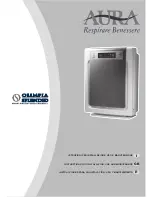
CyberOne EC DX IOM Manual
per local and national electrical codes for service to the
equipment. Do not mount a customer supplied manual fused
disconnect switch or HACR type circuit breaker to the surface
of the unit.
CAUTION
Prior to unit operation, an adequate unit-to-earth
ground must be connected to the unit.
NOTE
All wiring must be provided in accordance with local
and national electrical code requirements.
It is important to verify that the main power supply coincides
with the voltage, phase and frequency information specified
on the system nameplate. The supply voltage measured at
the unit must be within ±10% of the voltage specified on the
system nameplate except for 208/230V single-phase units
which have a different tolerance listed below.
2.7.1.1
Single-Phase Units 208/230V
The supply voltage for units that are designed for 208V
operation must have a tolerance within -5% and +10%. If the
measured supply voltage is 230V, the unit can operate with a
tolerance of ±5% if the following change is made. The control
transformers within the system must have the primary wire
connected to its respective 240V tap instead of the 208V tap.
2.7.1.2
Single-Phase Units 277V
Single-phase units require the hot leg of power to be
connected to terminal L1 and the neutral wire to terminal L2
of the main power non-fused service switch.
2.7.1.3
Single-Phase Units (208/230V) with
277/230V Buck/Boost Transformer
Applications (See Figure 12)
Certain applications may require the purchase of a unit
designed for a 208V, 1PH, 60Hz power supply and
supplied with a 277V/230V buck/boost transformer.
This configuration allows the equipment to operate from
a customer supplied 277V, 1PH, 60Hz power supply. The
purpose of the buck/boost transformer is to convert the
incoming 277V, 1PH, 60Hz power supply to the required
230V, 1PH, 60Hz power supply for unit operation. If the
incoming power supply is within the range of 277V plus 5%,
the control transformers within the system must have the
primary wire connected to its respective 240V tap instead
of the 208V tap.
Upon examination of the buck/boost transformer, it may
be observed that the labeled primary voltage is 120, 240
and/or 480 while the secondary voltage is 12, 16, 24, 32
and/or 48 but it’s not necessarily limited to these voltages.
The transformer is designed as an insulated transformer. It
may be wired in a configuration, as recommended by the
manufacturer, to modify its electrical characteristics to those
of an autotransformer (buck/boost transformer). The primary
and secondary windings are no longer insulated, which in this
design produces a lower voltage ratio between the primary
and secondary windings. This new wiring configuration also
results in an increased kVA capacity.
It should be noted that the 277V/230V buck/boost
transformer provided with the equipment has been properly
sized and is approved for use as a buck/boost transformer.
The buck/boost transformer must be installed, wired and
provided with overcurrent protection in accordance with local
and national electrical code requirements. Please refer to the
electrical drawing supplied with the unit for field connections.
A means for disconnecting main power is required for the
system; sizing and location will depend on the location of the
buck/boost transformer with regards to the unit. In addition,
wire sizing and overcurrent protection must be provided in
accordance with the unit nameplate information given for the
buck/boost transformer and the unit.
NOTE
This transformer is used on a wide variety of
applications. Use the wiring instructions (the same
instructions are supplied with the transformer) for
the correct wiring method. Care should be taken
to wire the transformer in accordance with the
electrical drawing supplied with your unit.
CAUTION
Do not connect any additional loads to the
system control transformers. Connecting
additional loads to the factory supplied control
transformer(s) may result in overloading of the
transformer(s).
17
















































